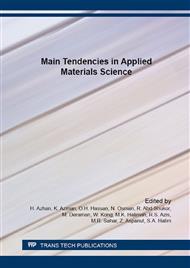p.479
p.484
p.493
p.497
p.505
p.510
p.517
p.523
p.528
Conductivity and FTIR Studies of NaI-Na3PO4-PLL Electrolyte for Solid State Batteries
Abstract:
The current solid electrolytes suffer from low ionic conductivity and interfacial instability. To improve the performance of the electrolyte, the addition of additives to the solid electrolyte is being extensively investigated. A Na–ion conducting solid electrolyte system was prepared via solid state reaction technique. NaI and Na3PO4 were mixed in varied compositions and the optimum composition obtained with the highest conductivity at room temperature was used to study the effect of polymer additive by using Poly (L–Leucine)–1,3–diamino propane. A small amount of Poly (L–Leucine)–1,3–diamino propane in the range of 2–10 weight percent was added to the optimum composition of the binary compound with a composition of 0.5 NaI and 0.5 Na3PO4. The effect of Poly (L–Leucine)–1,3–diamino propane on the electrical conductivity of the binary compound was investigated by Electrical Impedance Spectroscopy (EIS) technique. Results from EIS have proven this compound to be superionic with maximum conductivity in the range of 10−3 S cm–1. Fourier Transform Infrared Spectroscopy (FTIR) analysis revealed the band of C=O at 1650 cm–1 experienced shifting indicates some interaction has occurred. The ionic transference number was found to be ≈ 1 for the optimum composition with maximum conductivity which suggests that the sample is ionic in nature.
Info:
Periodical:
Pages:
505-509
Citation:
Online since:
March 2016
Authors:
Price:
Сopyright:
© 2016 Trans Tech Publications Ltd. All Rights Reserved
Share:
Citation:


